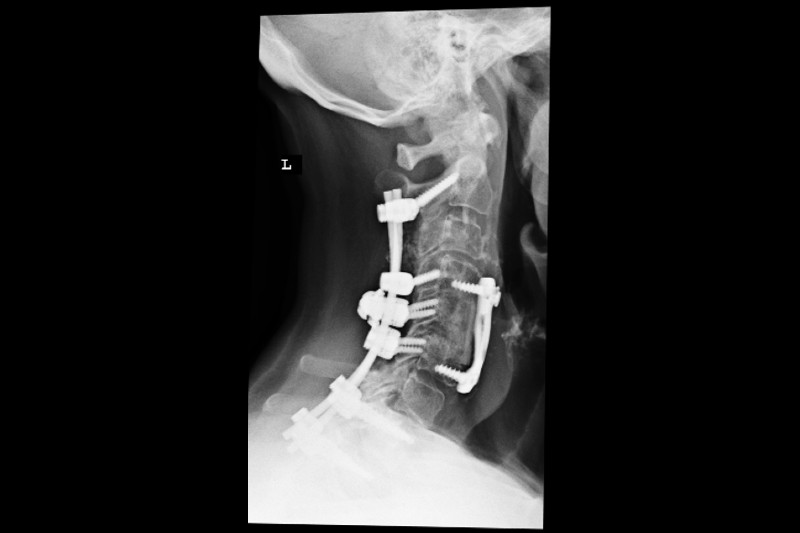This procedure is used to relieve compression or pressure on nerves caused by spondylosis, herniated discs, or spinal stenosis. Posterior cervical laminectomy can be utilized for spinal compression occurring on multiple levels to help relieve compression on the nerve roots and spinal in the neck.
When Is This Treatment Necessary?
When the spinal canal in the neck becomes narrow, a condition known as cervical stenosis occurs. This puts pressure on the structures of the spine. This can lead to symptoms including tingling in the legs and arms, neck pain, problems with the bladder and bowels, and a lack of coordination. Spondylosis, herniated or bulging discs, and disc degeneration are just a few of the conditions that can lead to the nerve roots or spinal cord become compressed. In some instances, multiple disc bulges may occur at multiple levels, and the spinal canal may become bound by ligaments, both of which can result in spinal stenosis.
What Is Involved In A Posterior Cervical Laminectomy?
This procedure involves the removal of the spinous process and lamina to ensure there is sufficient room for the spinal cord with the aim of relieving pressure. Patients who are experiencing severe stenosis may have to have three or more segments of the spine treated, with a posterior longitudinal ligament resection occasionally being necessary to achieve decompression. In such cases, the posterior approach is generally used in preference of the anterior approach due to the ease of accessing the desired areas with the former procedure. In multilevel laminectomies, there may be a post-operative risk of deformity or pain caused by additional instability resulting from the treatment. For this reason, this type of procedure is typically performed alongside a posterior fusion to ensure stability. If three or more levels are involved, a posterior approach will be used due to added difficulty. In these cases, a bone graft will be included in the posterior cervical fusion to ensure the vertebrae have sufficient support.
How Is The Posterior Cervical Laminectomy Performed?
The procedure starts with the opening of a 3-4 inch incision along the posterior portion of the neck along the midline. Once the muscles have been lifted off the lamina, the next step can be performed. At this point, one of our providers will remove both the lamina and the spinous process in one piece using a high-speed burr so that the spinal cord will have sufficient space. In most cases, an autograft bone taken from the patient will be placed into the newly empty space in the vertebrae to help new bone growth to begin. Screws and rods are then placed along the spine to help hold the structure together while it heals.
Risks and complications With A Posterior Cervical Laminectomy
The most common risks and complications associated with this procedure are bleeding, fusion failure, infection, nerve injury, and the common risks associated with anesthesia.
If you have more questions about this procedure and are wondering if it may help relieve your symptoms, it’s time for a call to one of the providers at Comprehensive Spine Care in New Jersey. Our team of experts has been helping patients in the New Jersey area find relief from pain and enhanced quality of life through procedures like these. Call today at 201-634-1811 to learn more about this procedure and begin your journey as part of Comprehensive Spine Care’s patient family.
CERVICAL LAMINECTOMY AND FUSION
Cervical laminectomy and fusion may be performed when there is severe compression of the spinal cord and spinal nerve roots at multiple levels from cervical stenosis.
Extensive compression of the spinal cord and nerve roots may result in severe symptoms of pain in the neck and arms as well as numbness and tingling in the arms or hands. Patients may also note difficulty with balance and/or with use of their hands to perform fine motor tasks such as buttoning buttons or handwriting.
The surgical incision is made in the center of the back of the spine. The length of the incision varies with the number of vertebrae involved. An operating microscope is then used to aid in visualizing the spine and carefully remove the bone and ligaments that are compressing the spinal cord. This is the decompression portion of the procedure (laminectomy).
When the bony structures that are causing compression are removed it is then necessary to stabilize the spine so that it may maintain its intended alignment. Small specially designed metal implants are then placed in order to help stabilize the spine as the body lays down its own new bone as part of the healing process (fusion).
After surgery:
Once surgery is complete the patients will spend a few hours in the surgical recovery area for monitoring.
- Patients will spend one or two nights in the hospital, where they are able to walk immediately and work with a physical therapist.
- A neck brace may be provided in certain instances to help support the neck.
All surgical patients at Comprehensive Spine Care are provided with medications prior to the date of surgery with instructions on their post-operative usage. Wound care, medication and diet instructions for after surgery are also provided upon discharge from the hospital and are also available here.











 in CA by O360®
in CA by O360®